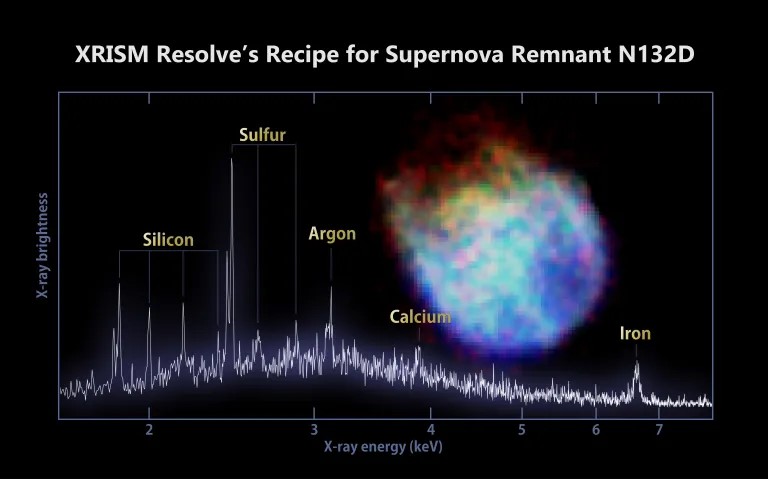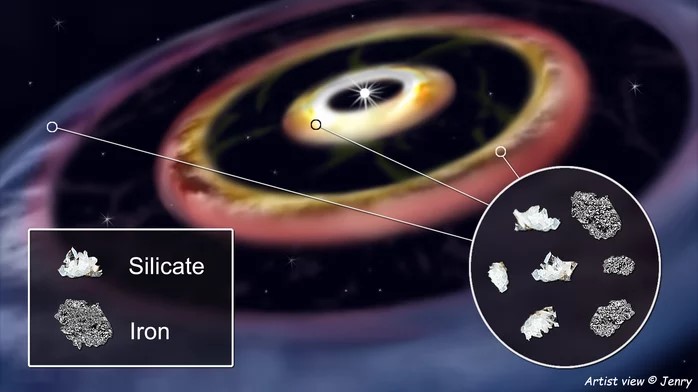XRISM's First Glimpse into the X-ray Sky
The Japan-led XRISM (X-ray Imaging and Spectroscopy Mission) observatory, launched on September 6, 2023, has recently offered a tantalizing preview of the groundbreaking data it is set to collect when regular science operations commence later this year. This joint venture between JAXA (Japan Aerospace Exploration Agency), NASA, and the European Space Agency (ESA) holds the promise of revolutionizing our understanding of the universe by providing unprecedented insights into the X-ray sky.

Figure 1. XRISM Resolve’s Recipe for Supernova Remnant N132D. (Credit: JAXA/NASA/XRISM Resolve and Xtend)
Figure 1 shows XRISM’s Resolve instrument captured data from supernova remnant N132D in the Large Magellanic Cloud to create the most detailed X-ray spectrum of the object ever made. The spectrum reveals peaks associated with silicon, sulfur, argon, calcium, and iron. Inset at right is an image of N132D captured by XRISM’s Xtend instrument.
Revolutionary Capabilities
Designed to detect X-rays with energies up to 12,000 electron volts, XRISM aims to explore the universe's hottest regions, largest structures, and objects with the strongest gravity. In comparison, the energy of visible light is a mere 2 to 3 electron volts. The mission is equipped with two cutting-edge instruments, Resolve and Xtend, each playing a crucial role in unraveling the mysteries of the cosmos.
Resolve: Unveiling the Chemical Makeup
The microcalorimeter spectrometer Resolve, developed collaboratively by NASA and JAXA, operates at a fraction of a degree above absolute zero inside a container of liquid helium. Despite encountering an issue with its aperture door, Resolve has already exceeded expectations, capturing a detailed X-ray spectrum of the supernova remnant N132D in the Large Magellanic Cloud. By analyzing peaks associated with elements like silicon, sulfur, calcium, argon, and iron, scientists can unravel the intricate details of the original star's composition and the explosion that led to the supernova.
Xtend: A Wide Field of View
Xtend, XRISM's second instrument, is an X-ray imager developed by JAXA. With a field of view 60% larger than the apparent size of the full moon, Xtend provides a comprehensive look at celestial phenomena. It recently captured an X-ray image of the rich galaxy cluster Abell 2319, showcasing its wide-ranging observational capabilities.
Challenges and Triumphs
While Resolve has encountered an issue with its aperture door, restricting its observations to higher-energy X-rays, the XRISM team remains undeterred. The Xtend instrument remains unaffected, and Resolve continues to perform exceptionally, exceeding anticipated spectral resolution. The team is actively exploring solutions to address the anomaly, ensuring that XRISM continues to push the boundaries of scientific exploration.
Looking Ahead
Despite challenges, XRISM is poised to revolutionize X-ray astronomy. The release of preliminary data offers a glimpse into the mission's immense potential. As regular operations are set to begin in 2024, the international science community eagerly anticipates the wealth of knowledge XRISM will unlock, providing a new dimension to our understanding of the universe.
Source: NASA/Goddard Space Flight Center
Cite this article:
Hana M (2023), XRISM's First Glimpse into the X-ray Sky, AnaTechMaz, pp. 14















